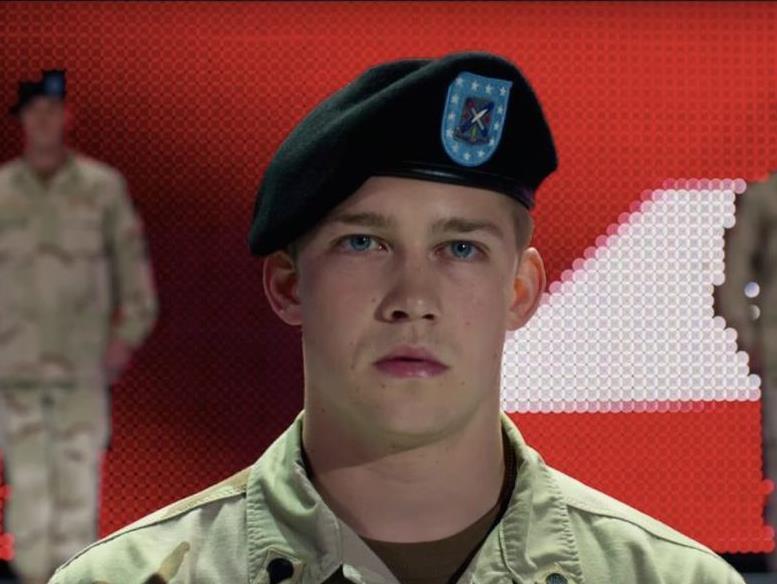Billy Lynn’s Long Halftime Walk mentions a journey by foot in its title, and spends much of its duration walking in a military crew’s shoes; however to step into Ang Lee’s latest film is to step into the head of its eponymous protagonist. In his first effort since 2012’s Life of Pi, the director once again champions technical achievement to ponder existential quandaries. Shooting in high-resolution 3D captured at 120 frames per second to maximise the life-like detail of the imagery (even if most cinemas aren’t equipped to project the feature in all its intricate splendour), Lee turns spectacle into an contemplation piece as a returned soldier grapples with the consequences of his service.
So it is that Texan teenager Billy Lynn (debutant Joe Alwyn) arrives home from a tour of Iraq to much fanfare, only to find that praise, media interest, and even his unit’s centrepiece role at a Thanksgiving football match’s halftime show can’t mask his inner post-war trauma. After burying his sergeant (Vin Diesel, The Last Witch Hunter) — and in the midst of preparing for the game, watching an agent (Chris Tucker, Silver Linings Playbook) try to sell the movie rights to his tale, and falling for an interested cheerleader (Makenzie Leigh, James White) — he becomes torn between the patriotism, camaraderie and responsibility of his active duty, as best exemplified by his squad’s leader (Garrett Hedlund, Mojave), and the non-combat path his worried sister (Kristen Stewart, Personal Shopper) urges him to favour.
Based on Ben Fountain’s 2012 novel of the same name, and adapted for the screen by first-time scribe Jean-Christophe Castelli (a researcher on Lee’s The Ice Storm, and associate producer on Life of Pi), Billy Lynn’s Long Halftime Walk conveys this conflict through three interwoven timeframes. As it traces Lynn’s actions on the day that gives the feature its name, the film offers flashbacks of the violent events in Iraq that gave rise to his heroic status, as well as slivers of his visit home to see his family. A loud noise, sudden movement, turn of phrase, crowd of people or display of fireworks in one of the movie’s three segments frequently inspires editor Tim Squyres (Unbroken) to segue, via matching sounds, actions or visuals, from one part of the story to another.
It’s almost impossible to miss the technical feats at the heart of the feature; indeed, Lee wants the flitting between the past and present, and the astonishingly pristine frames shot by cinematographer John Toll (Jupiter Ascending), to garner attention. Still, with the film earnestly trying to examine both pro-troop and anti-war sentiments, as well as unpack just what that means to soldiers both on the ground overseas and upon their return, and explore the exploitative, entertainment-fuelled circus that surrounds the aggressive industry, it is easy to overlook just how important the Billy Lynn’s Long Halftime Walk’s visual style and intertwined snippets prove in an emotional sense. At once oh-so-realistic and uncannily tinged with the surreal, they mimic the heightened sensations Lynn visibly experiences — and the chaos, as well as the contrasting confusion and clarity, that goes with it. And, while the feature’s aesthetics can’t overcome the intermittent clumsiness inherent in the way some of the underlying sentiments are handled, they can, and do, plunge the audience into the protagonist’s mindset.
Mid-way through the film, Lynn utters a telling line that gets to the core of the concept the movie wants to express: “it’s sort of weird, being honoured for the worst day of your life,” he advises. Saying this isn’t enough; the entirety of Billy Lynn’s Long Halftime Walk is designed to demonstrate the truth of these words, as much as it can to an audience that hasn’t been in the same situation. As an often-sensitive director of performers, Lee’s casting choices certainly assist — from the naturalism of Alwyn’s facial expressions to the candour of Hedlund’s delivery, with the pair acting as the internalised and externalised manifestations of military living. Given perspectives to embody more than characters to portray, Stewart and the rest of the cast mightn’t fare as well, but they do contribute to the one thing the feature renders best: with an impassioned plea here, an arrogant offer there, and a brotherly pat-on-the-back in between, they’re part of the heady, immersive minutiae swirling around a man trying to find a space between war and normality.
Rating: 3 stars out of 5
Billy Lynn’s Long Halftime Walk
Director: Ang lee
UK | Taiwan | USA, 2016, 110 mins
Release date: 24 November
Distributor: Sony
Rated: MA
Actors:
Director:
Format:
Country:
Release:





